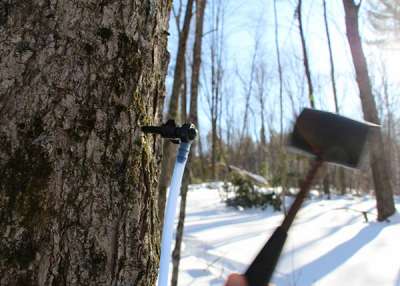We usually start tapping our sugarwoods around February 1. This year it was five below zero that morning, and so there was no rush getting out there. If it’s too cold when you tap, you can split the bark on the younger, thin-barked maples. What looks like a tiny tear in February can grow into a ragged scar by April, a symptom of frost expanding in the wound. And so we went logging instead – we’re working on a series of patch cuts in the sugarbush to promote songbird habitat. And then we went home and watched the Patriots give the Seahawks a Gronking to remember in the Super Bowl.
I don’t have to tell any of you Northeasterners that the weather didn’t get any warmer all month. (Though if you’re a Pats fan, you at least had a warm, fuzzy feeling inside to bide you through the worst of it.) In a lot of places, the month was the coldest on record. And not just by a little. Montpelier, Vermont, where the average temperature was 5.1°F, broke their all-time record by a full 3 degrees. At some point we had to start tapping, and so we did, stealing a few hours here and there during the warmest part of the days.
I also don’t have to tell any of you that there’s a lot of snow out there. Around February 1 it was shin deep in our woods; by mid-month it was mid-thigh. We’ve been floundering. Someone floated the idea that we hire unskilled labor to break trail from tree to tree, and how I wish such a labor pool were available.
As I write this it’s March 6, and we’re about half-tapped. Thankfully there’s no sense of urgency yet. It looks like we’ll probably get our first sap weather early next week, but everything is so frozen up that the run will probably be relatively minor. The trees are frozen solid and presumably there’s a lot of frost in the ground. We’ll collect what we can and be happy for it, all the while making a big push to get our other bush up and running and reminding ourselves that we’re supposed to like cold and deep snow.
Looking at the big picture, one of the big, stories going into this year is industry expansion. Around the office in Corinth, big sugarbushes are popping up along roadsides like coltsfoot in April. A couple of our board members are involved with a new, roughly 200,000-tap operation that’s being built in northeastern Vermont. Over in the northwest part of the state, sugarmaker J.R. Sloan has become the nation’s biggest single producer. Down in the southwest near our sugarhouse, a New York producer with aspirations of half-a-million taps is reportedly installing 100,000 of those in a bush in Rupert, a town where there’s probably 50,000 maples already being tapped. Maple’s becoming really big business throughout the region.
What’s this going to do to the industry? Who can tell. Most big, corporate types I talk to think it’s great. Whereas in the past the big packing companies (who sell most of the world’s syrup) had to rely on a bootleg network of producers for their product, today they can lock in supply agreements with big operators; this guarantees a more consistent product, both in quality and quantity. The quantity and consistency part is really important to them. They’re trying to make inroads in the non-boutique U.S. market – think Walmart – where margins are razor thin, and internationally, where all the bullish-on-syrup types are salivating over the billions of untapped Chinese consumers. They need a steady supply of product at a consistent price. Volatility scuttles multi-million dollar deals.
Of course, the flip side of this coin is that an ample supply of syrup means lower prices for producers. If you started sugaring five years ago when bulk prices were $4 a pound, you’ve since seen the price drop around 40 percent. You better not have been counting on that first number to pay back your bank note. Commercial syrup has dropped to about $0.75 a pound – if you can find a packer who wants it.
Many of the smaller producers I talk to lament the boom. They worry the industry is going to produce itself into oblivion. They don’t like the increased competition or the lower prices or the rumors they hear about the government wanting to require hair nets and hand wash stations and flush toilets in sugarhouses. They sort of hate that this quaint, romantic endeavor is becoming such big business; the family sugaring operation being co-opted by venture capitalists and global commodity traders, the sugarhouse becoming a sugarfactory.
In our own operation we’ve lost several of our boutique market accounts to lower-priced competition in the past five years. And with falling bulk prices, the syrup that we hold over in drums has been steadily losing money just by sitting there. (Barring a terrible production year that increases demand, this should only get worse in the short-term; Canada is sitting on 65 million pounds of surplus, and dollar for dollar their syrup is 18 percent cheaper than ours based on exchange rates.) That said, the syrup boom has allowed a sugarmaker up the road to expand significantly; he needs sap and we’ve been selling it to him. Over the past few years this has become a big part of our business model – in fact, this year we’ll probably sell more sap than we boil. This roils the nostalgist in me, but I’ve got to admit that it’s pretty nice going to bed at 9 at night with money in my pocket instead of 3 a.m. after a night of boiling to produce syrup that I then have to sell before I see a dime.
By all means share your own thoughts on the industry with the group. What does it look like from where you sit?


